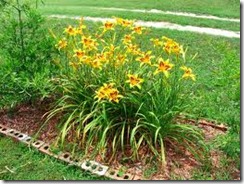Nursery catalogs offer dozens of daylilies in different forms and growth habits, but plants may not exactly match their extravagant catalog descriptions when they bloom in the garden. The American Hemerocallis Societ (AHS) offers a reference to check claims by providing a central record of information about cultivars registered with the society by their hybridizers.
Hybrid Heaven
-
From the original stock of diploid plants — plants with two sets of chromosomes — with lily-like orange and yellow flowers, plant geneticists and amateur breeders have created thousands of hybrids. They appear in every color but blue and in double, spider, peony and flat, round flower forms on plants from 8 inches to 4 feet tall. One hobbyist, Pauline Henry of Siloam Springs, Arkansas, created over 450 cultivars. The AHS register records and recognizes the best of this work.
The Register
-
Registered cultivars represent a fraction of the hybrid offspring created each season because breeders submit their best work. Society members subscribe to a set of procedures that include record-keeping and naming standards. Seedlings of cultivars nominated for registration accompany registration forms, and a digital photograph and contact information document ownership. Registration applications submitted before November 1 are added to the AHS checklist. AHS-registered cultivars represent standards accepted in the United States and Canada. They are also recognized by the European and Australian Daylily Societies.
Descriptions
-
The form requires major standards including the size of plant, scape (branch that bears flowers) and the size, fullness and petal shapes of flowers. In addition, the number of branches and flowers on each scape and the plant’s potential for reblooming explain the plant’s probable display in the garden. Flower shape, color and color patterns as well as characteristics such as ruffling, midribbing, tepal textures and other specifics complete flower descriptions. Plant "ploidy" — number of pairs of chromosomes — and whether dormant, semi or fully evergreen help determine further cross-breeding potential, hardiness and growth habits. Other required descriptions include fragrance and the time of commencement and length of bloom. The AHS also requests hybridizers submit supplementary information for previously registered cultivars because variety in size, shape and growth habit of daylilies has expanded and definitions changed as the species has grown.
Names
-
A name committee reviews all names as the last step to recognition. Names for individual plants must follow certain conventions established by the International Code of Nomenclature for Cultivated Plants (ICNCP). As with descriptions, naming conventions change and at time of writing, the eighth edition of the ICNCP rules applied. Names must be in English and may not contain the word Hemerocallis or daylily. They could not contain the name or part of the name of a Stout medal winner or substantially sound like an existing cultivar. The prefix "Siloam" is reserved for cultivars bred by Pauline Henry in the last century: newer garden name prefixes are discouraged. Legal permission for use of personal names must accompany applications.


Deprecated: strpos(): Passing null to parameter #1 ($haystack) of type string is deprecated in /home/agriviek8Qv/agriviet.net/public_html/wp-includes/comment-template.php on line 2522